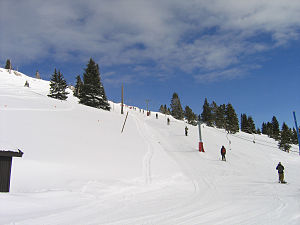- Surface lift
-
A surface lift is a type of cable transportation system used to transport skiers and snowboarders where riders remain on the ground as they are pulled uphill.
Types of surface lifts include the Poma lift, J-bar, T-bar, rope tow, and magic carpet.[1]
Although these types of lifts were once prevalent, they have since been overtaken in popularity by higher capacity aerial lifts like chairlifts and the gondola lift. Today, surface lifts are most often found on beginner slopes and very small ski areas.[2]
Surface lifts have the advantage of being less intimidating, especially for beginners: the speed is slow (relative to aerial lifts), they are usually situated on beginner terrain, the passenger's safe loading window is wider than most types of lift, and remaining on the ground is perceived to be more controlled than off the ground. They are also generally less expensive to construct and maintain than an equivalent length aerial lift.
The disadvantages of a surface lift include less passenger capacity (in terms of passengers per hour). They add a larger terrain obstacle and collision hazard. Surface lifts are restricted to smooth, gradual terrain, and require more new passenger skills than most types of aerial lift to safely ride.
During the summer of 2010, Vail Ski Resort in Colorado constructed an "elevated" surface lift, which provides transportation from to the top of the tubing activity, just off of Eagle's Nest. The degree of the slope is too great for a conventional surface lift, so the resort built the lift into the air.[citation needed]
References
- ^ "Glossary Entry: Surface Lift". SkiLifts.org. Archived from the original on 2007-03-02. http://web.archive.org/web/20070302110923/http://www.skilifts.org/glossary.htm. Retrieved 2007-04-16.
- ^ "Technical Information for lifts". SkiLifts.org. Archived from the original on 2007-02-06. http://web.archive.org/web/20070206113418/http://www.skilifts.org/technical.htm. Retrieved 2007-04-16.
Ski lifts Aerial lifts 
Surface lifts Cable railways Categories:- Vertical transport devices
- Surface lifts
- Ski lifts
Wikimedia Foundation. 2010.

